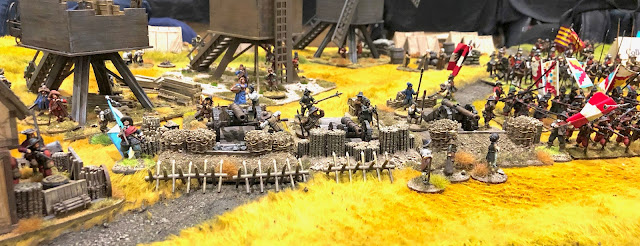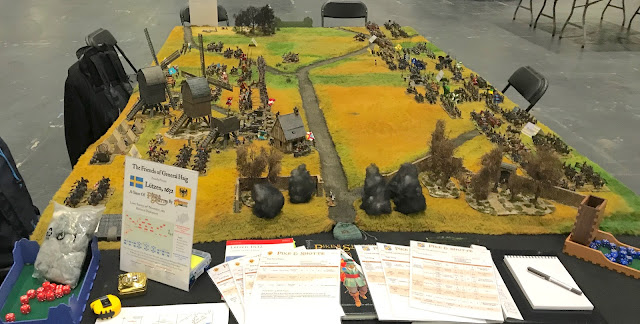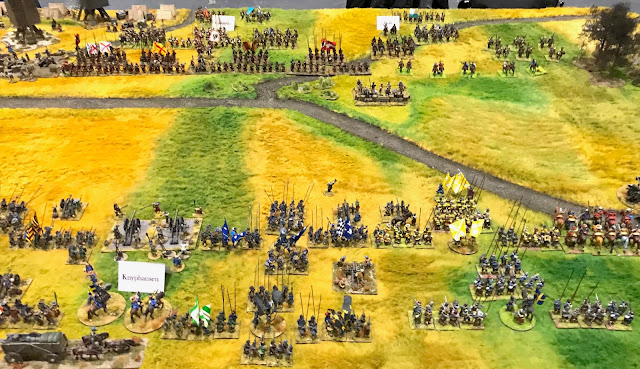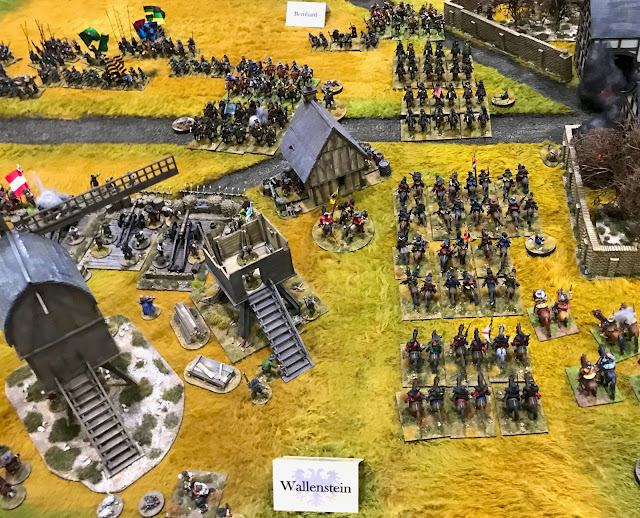I’ve already written quite a few words about he day of Salute on the 6th April, but not yet actually written much about the Lutzen 1632 refight played out by the Friends of General Haig on the day. This post therefore aims to correct this omission, and is the official battle report.
The order of battle has already been covered in a previous post here.
The troop rosters, set out for Warlord Games’ Pike and Shote, are also shared on Google drive here.
We had divided each army into three commands. We had six players and an umpire and so to start with we divided the commands among the six players. As the day went on we allowed the players to have time off to go and see the rest of the show and so other commanders in the same army would take temporary control of their command. The Imperial army had a fourth command (Pappenheim) which would arrive later and we decided to allow Wallenstein to command that in addition to his own command.
You can see it is a fairly cramped battle field, without much room for manoeuvre. This was intentional, as the cramped conditions were all part of Wallenstein’s defence. He knew that Gustav would try to outflank him and so he used the terrain to mitigate against this. He also refused both flanks in an echelon formation, with some skirmishing Croats thrown forward to further protect each flank.
Wallenstein had the town of Lutzen burned to prevent the Swedes taking it and attacking through it. He also used commanded shot to hold the gardens that surrounded the walls of the town. The Imperial army also had two artillery redoubts, and had fortified the Miller’s house next to the Windmill battery. The final Wallenstein touch was arming a group of camp followers to look like an infantry reserve on the left flank.
On the Imperial right we see the Windmill battery, the Miller’s House and the town of Lutzen. There is little room for the Swedes to exploit their advantage in cavalry numbers here.
They will need to take the gardens and the Miller’s house to allow they cavalry to move through the gap. Wallenstein’s command here looks secure.
In the Imperial Centre we can see Colloredo has strength in depth, with cavalry units also mixed in the second line of the foot regiments.
The Imperial left under Holk looks the weakest position. There is plenty of skirmishing light horse to try and slow down the Swedes. Also some camp followers cowering at the back!
On the Swedish right we see Gustav Adolf II ready to attack the Imperial position. (In fact he is still waiting for his commanded shot and some more horse to deploy in this picture.)
In the centre Knyphausen has six infantry brigades, all in their 3 squadron formation with light guns attached. The front three brigades are the elite Yellow, Old Blue and Green brigades. There is also the Swedish heavy artillery position.
On the Swedish left Bernhard of Saxe-Weimar has little room to manoeuvre and has the defended gardens of Lutzen to deal with.
The game started with the Swedes taking the first turn. Gustav had no doubt what was required and immediately charged forward with his cavalry. In fact, so keen was he to get to grips with the Imperial cavalry opposite that he decided to leave behind his slower moving commanded shot while he chased away the skirmishing light horse defending the Imperial left. The Croats were dealt with in fairly short order but they had done their job and delayed the Swedes for a little while.
The Imperial commanders knew they were out numbered on their left and they decided to move the reserve cavalry from the centre over to bolster the left flank. This had a decisive effect and Gustav’s attack was quickly bogged down. All of the Imperial horse had been made Caracole troops which in Pike and Shotte means they can not countercharge enemy horse. This allowed the Swedes to have a slight edge in initiative to reflect their aggressive cavalry tactics. However, the Imperial cuirassiers were still very tough nuts to crack. Units were lost on both sides.
Meanwhile the Swedes ground forward in the centre. There were moving in to a storm of fire from Imperial Muskets and artillery. But they managed to give back pretty much as good as they got. The command dice were not kind though and it was hard work for Knyphausen getting his brigades forward.
The player taking the role of Gustav was well aware of the historical fate of the Swedish king at this battle. Despite this he did risk Gustav in a melee in an attempt to break the Imperial line. There was a collective sharp intake of breath as the dice were rolled for risk to the general in combat. He survived, and won the melee. After this Gustav was kept out of the fighting.
On the Imperial fourth turn they could roll to see if Pappenheim arrived. A 5 or a 6 on a D6 was required and a 5 was duly rolled. Pappenheim’s troops arrived and charged straight in to the fray on the Imperial left. Just at this moment, Holk, who had been commanding the Imperial left, was killed in a melee. Pappenheim had arrived in the nick of time.
In the centre the Old Blue brigade were up to the Imperial line but the rest of the Swedish Brigades were still struggling to come up. Both sides were losing units due to the concentrated firepower of close range muskets and guns. (The grey smoke indicates units disordered by enemy fire.) Frustrated by the Imperial defences Bernhard decided to demonstrate with his cavalry against the Imperial windmill battery.
Bernhard also sent his cavalry to attack Wallenstein’s flank, but to no avail. A storm of musket and carbine fire prevented his Saxon horse from making any impression. Perhaps their hearts were not in it! No such qualms for Bernhard’s lifeguards who continued to threaten the heavy guns, and suffered accordingly.
The tide had now turned against Gustav and it was only the Swedish Commanded shot and support from the Yellow brigade that halted Pappenheim’s rampaging cavalry. It seemed that a stalemate was being reached on the Swedish right, Imperial left. The Imperial forces couldn’t break through the combined arms of the Swedes, and the Swedes had lost too many cavalry to push forward.
Could the Swedish centre save the day? The Swedish infantry brigades had finally made it to the Imperial battle line. You can see here only a few reserves and the Swedish heavy guns left on the Swedish side.
The Imperial commander in the centre, Colloredo, was not going to let the Swedes dictate this final phase of the battle, and as the Swedes approached, Colloredo marshalled his reserves and counter attacked. Imperial pike blocks stormed forward in to the Swedish formations. The Imperial troops had the best of the ensuing melees, but the couldn’t break the Swedes.
With stalemates along the whole line of battle , and darkness falling, the two sides had to withdraw. The Swedish attack had been stopped, so a marginal victory to the Imperial troops. But Gustav had survived (as the god like finger points to in this picture!). It would have been fascinating to fight a second day, but sadly the Excel centre wanted the hall back, and so we had to end it there.
This was the Friends of General Haig’s first Thirty Years War game, and so I was very pleased that all of the commanders had really enjoyed the game, and all were eager to play it again. Both sides were sure they could pull it off next time. I think this is a good sign that we have a well balanced game. The rules worked well, and all the players felt we had the factors about right. I am certainly really looking forward to getting these troops on the table again!
Until next time!

























This display is even better than first thought when photos from your Salute game began coming in. Marvelous work, an impressive spectacle, and a real treat to view! Well done!
ReplyDeleteThanks, Jonathan!
DeleteGreat to see and hear how the game actually played out.
ReplyDeleteThanks, Ray. We all enjoyed the game, and are looking forward to more TYW games now we have the collections battle ready.
DeleteVery beautifull and big battle!
ReplyDeleteTerrain and figures!
We love especially the so reallistic windmill!
Bravo! :-)
Thank you, Zoom! Much appreciated. The windmills are an iconic part of the battlefield :-)
DeleteI have just scrolled back through this and your previous posts on the build up for the big battle. You and your colleagues have done a superb job on producing a well researched and wonderful collection and battle report.
ReplyDeleteCheers,
Pat.
Thanks, Pat! Much appreciated :-)
DeleteWonderful terrain and armies, looks superb!
ReplyDeleteThank you, Phil. You are very kind :)
Delete